Bug Out Bag (BOB) or “Get Home Bag” DIY Checklist
This post may contain affiliate links. Read my full disclosure here.
This post is a DIY Bug Out Bag (BOB) summary for food, supplies and tactical gear, for everyday carry and emergency preparedness.
What is a Bug Out Bag (BOB)?
A bug out bag is a kit that has all the stuff you need to get from where you are to where you need to go. They are also known as a Get Out of Dodge bag (GOOD), a 72 Hour Bag/Kit, a “grab bag”, a “battle box” or a “Personal Emergency Relocation Kit” (PERK). A simpler one is the “Get Home Bag”.
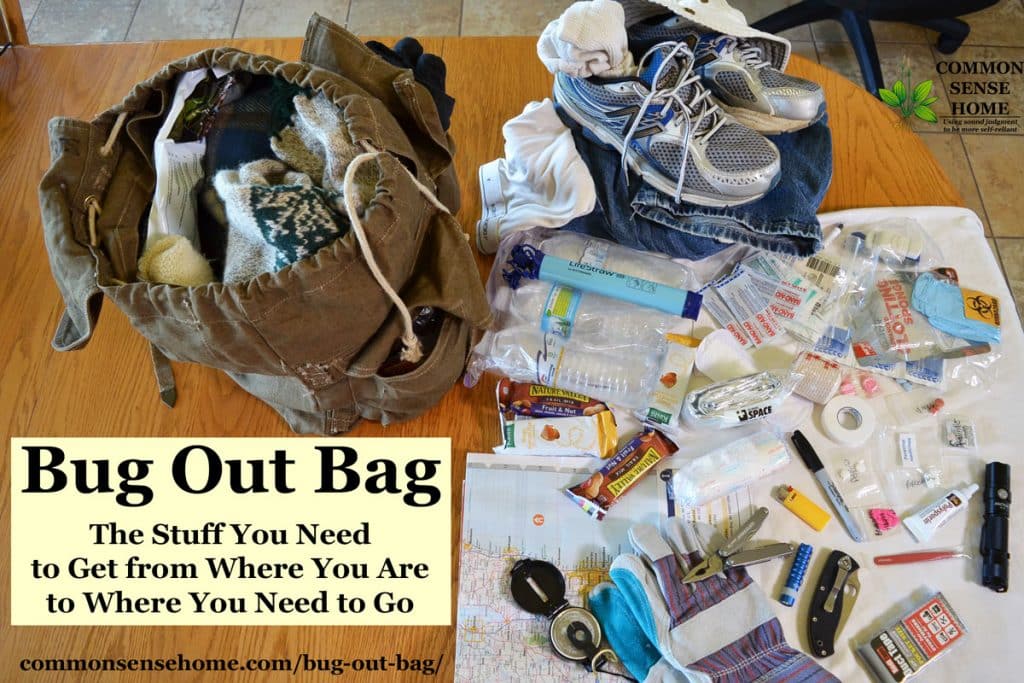
The Bug Out Bag (BOB) is intended to get you to your destination safely. It might be from school to home, or from home to your camp, or from home to a relative’s house. It can also be a kit you grab to evacuate, due to flood, tornado, fire or other man-made or natural disaster.
The phrase “bugging out” basically means evacuating a location quickly. Each of these types of kits are quite different. A BOB might have 72 hours worth of food and supplies, or have extra clothing and supplies to walk home or both. There is no single simple kit that will fit everyone’s needs.
Table of contents
Basics for My BOB
There are hundreds of lists that identify what someone else thinks you should put in your bug out bag. Instead of trying to identify every item, we want you to think about why you need a BOB and what you need in your bug out bag.
What is a bug out bag used for?
Think about out what you are planning to deal with.
Is the BOB going to let you walk from work to home, or home to the cabin, or school to home? Is it a full survival kit? What weather is likely? Do you need a summer and a winter kit?
Do you need 24 hours of food/water or 72 or more to get from where are to where you need to be? What about 24 or 72 hours of items for your vehicle to survive in a remote area?
What types of emergencies are you planning for – fire, snowstorm, tornado, hurricane, car accident, earthquake and so on. A sunburn kit won’t help much if you need a frostbite kit (or vice versa).
Will you be out in the middle of nowhere where it will take two hours before help arrives or where another car might not see you for days or will you be in the city where cash and a backup cellphone or charger might be more important?
You need a real bug out bag (grab bag) or emergency kit, if you live in an area that is prone to earthquakes, snow storms, forest fires, tornadoes, flooding, volcanic activity or other predictable natural disasters.
Basic Contents for a Bug Out Bag
Adjust and customize these based on the answers to “what do you need a bug out bag for” section above.
- Walking Clothes (full change of clothes, including underwear)
- Food and water (24 to 72 hours or more)
- PAPER MAPS & compass to get you home if your phone GPS stops working
- First aid supplies, including prescription medications
- Other basic supplies
Traveling on foot
If you have to travel on foot remember the military saying “ounces equal pounds and pounds equal pain”. Only pack what you need and what you need and what you will use. What you need will determine what you stock in your kit.
Weight Matters
If you are traveling in a car across country and sleeping in your car, weight is not a big deal. If you have to abandon your car, weight becomes a huge challenge. Everything must be lightweight, small and durable. A phrase that is appropriate is “Ounces are Pounds”.
Getting lightweight items that are small and durable is expensive. A Spyderco G10 knife is 4.1 ounces and about $60. The Benchmade Bugout is 1.8oz and is over $110. This is almost double the price to cut the weight in a little over half.
Customize MY Bug Out Bag
Customize your bug out bag to your location, your personal and family needs, your specific medical and physical needs. Modify it based on what you can afford.
Pick items that are multi-function. Fishing line may not be necessary, if there are no fish within 100 miles, but it could still be a lightweight alternative for an animal snare, or even string for a tarp. If you are on foot and miles from home and civilization.
Get rid of unnecessary packaging. Even an MRE or SOS kit can get stripped down some so it takes less space and more importantly weighs less. If you are really packing for a long walk strip off ALL unnecessary packaging, combine water into full containers.
If you are into self defense, you may have a small conceal carry pistol or other defense weapon. Again weight matters. If weapons are illegal or you are a pacifist you might still want to get mace, a taser, or some other non-lethal defense or a whistle to draw attention.
Modify your kit to meet the area you live or travel in, whether that is with warmer clothes, or sunblock and a hat, or long underwear and mittens.
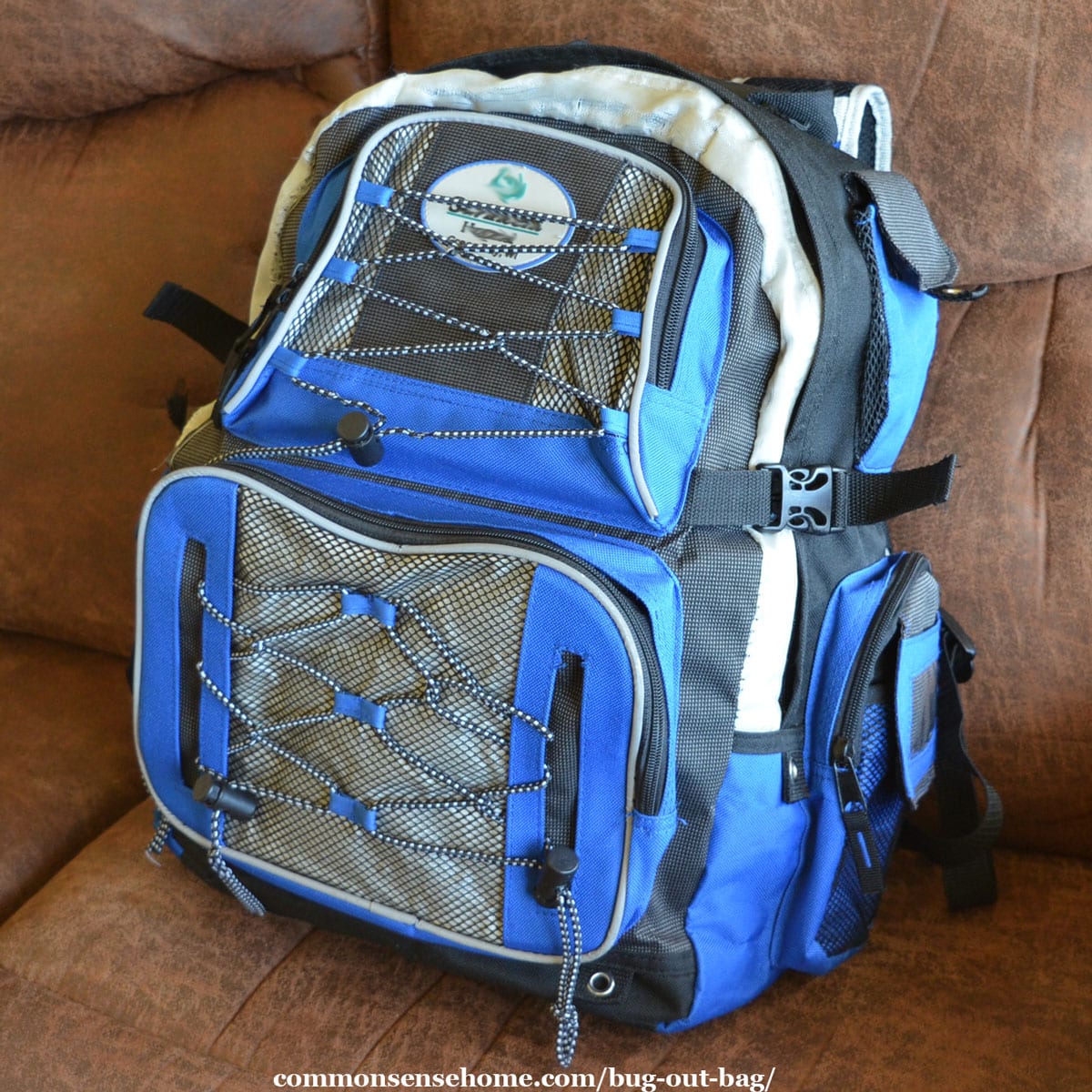
DIY Bug Out Bag (Get Home Bag) Checklist
Your Bug Out Bag or Get Home Bag might not include all these items. We want you to consider these in rough priority order, and get you thinking. Review each item relative to your needs, and only pick what you absolutely need and know how to use.
Note – we focus a lot on a car kit, but think of the car kit as a kit you will pick through to create your Get Home Bag. Only leave your vehicle if you must. Your car conserves heat, provides some safety, and protects you from bad weather.
Bag Out Bag Items Details
The Backpack
Put a good backpack in your trunk. There is no magical perfect backpack. If you can, go to an outdoor store, try a few before you select one. You can load up your car with supplies and then if needed load those items into the backpack.
If you don’t have the money, get a cheap one to start. Thrift stores are helpful. The backpack we recommend is 40 to 62 Liter so a 72hour kit size. If you are planning longer you will need a larger backpack.
Walking Clothes
Pack a change of clothes including a couple pairs of underwear. Pack the clothes relative to the location and season. A wide brim sun hat matters if you are walking in the sun long distance.
Cold is just as much a risk, if not more of a risk, and having a bit more than you need is not a problem in a car, but don’t over pack for a long walk home. Pack the right stuff.
Maps
If you know your area well enough you might not need paper maps, but consider getting them for the car, just in case. Also consider a compass and practice with it. Paper maps don’t require any electronics, but are harder to find now.
Food
Stock enough food in your trunk for 24 to 72 hours per person (and don’t for get a pet if it is along). The food should be temperature stable, high calorie low weight such as energy bars or SOS bars.
Food could include dehydrated food or freeze dried food which will last even longer. If you are packing a lot of dehydrated food be sure to pack extra water. SOS bars are a bit heavier but they also won’t require as much water if you are in very dry environment.
Water
Water is heavy BUT it is absolutely critical. You need it even more than you need food. Stock enough water in your trunk for 72 hours per person (and pet). Maybe a 6 pack of water bottles per person.
If you think you will need to walk long distances, a Lifestraw water filter may be a better pick, IF there is water along the route. Pack extra if you are in high heat areas or in a high heat season. If you have extra, drink a lot before you leave the car or home.
In colder areas water will freeze and expand so pick tougher plastic water bottles. If you want to be 100% sure drain a bit out. The bottles should be about 4/5ths full so they could expand without breaking when frozen. Pack extra if you are in high heat areas or in a high heat season.
Medical & First Aid Items
Whether you pack a basic first aid kit or advanced first aid kit depends on your skills and knowledge. Carry what you know how to use, and will likely need.
Focus on medical care to sustain life without medical aid for 3 days. It MUST include critical prescription medicines, epi-pen if you need it and inhalers and so on. Get training, its always with you and doesn’t weigh anything.
This is especially critical if you are an area where professional medical aid could be hours or days away. If you don’t have a First Aid Kit at least get good lightweight first aid kit such as the SurviveWare 16oz kit, NorthBound Train kit 11oz or the Adventure Medical .7 Kit 8oz.
Buy what you need. Review what it comes with, the weight and most importantly, your likely circumstances. Personally, I always have QuikClot gauze in my car, in my office and at home, and in a get home bag.
For more on First Aid Kits see the Best First Aid Kit Recommendations for Home, Car, Office and Travel post.
Flashlight
A good LED flashlight with an extra battery or two. We recommend either the small lightweight AAA Lumintop EDC 01 or the larger very bright 18650 Thrunite TN12. Having multiple flashlights in the car is a great idea, as you can pick and chose based on the situation. (Click here for the full review of the Lumintop EDC01)
The flashlight can be used to slow traffic, signal for help, seeing in the woods, change a tire, or just seeing under the car in the dark. The weight of an extra AAA battery or 18650 battery is minimal, and you will be happy you have it if you are on foot over long distances. Remember to change out batteries in flashlights Spring and Fall of each year.
Sharpie Marker
Sharpie pen, you can write on nearly anything with it, so you can leave a note if you have to bug out on foot or leave notes in other locations.
Duct Tape
Either a roll of duct tape and/or the Reditape Pocket Duct Tape.
Would you like to save this?
This stuff is insanely useful. Patch a hole in your clothes. Seal a sucking chest wound, create a temporary split, create a rope for a tarp, put a rear view mirror back on, tape a bumper on. It is magic.
The pocket duct tape weighs less and is a better pick if you plan to have to walk long distance.
Knife
Spyderco knife, the Kershaw knife or our favorite Benchmade Bugout. Either one is good, high quality and sharp. You should have a survival knife in your car anyway, so grab it from your car.
Fire
You may also want a way to start a fire, such as waterproof matches or a lighter.
Clipper Lighter or some other lightweight fire starter – a magnesium fire starting tool or matches are options. Fire is warmth, can sterilize water and can heat the knife so you can cauterize a wound. (We like Clipper lighters more than BIC lighters)
Cash
Always have a stash in case of emergencies. In most cases, cash is a better than rope or a compass or other items.
A pack of gum
Consider a pack of gum, tin of mints, or hard candies. Something it gives you something fresh in a social emergency and something to suck on in a real emergency. Another item that fits multiple roles is lip balm.
Hygiene
A roll of toilet paper or two in a ziplock bag, inside a rolled up garbage bag. You want the garbage bag in case you are stuck in the car for a few days. Stash feminine hygiene products. Having a stash for ladies in the family or even just friends could make a big difference, and feminine pads (not tampons) can double as heavy gauze for a serious wound.
Gloves
Whether its hot or cold, wet or dry, make sure you have appropriate work gloves.
Blanket
Leave a Wool Blanket or at least an emergency blanket in your car so you can get some sleep, and possibly carry it if it’s cold and you are forced to walk home cross country. Items that are less critical below.
Cellphone charger
Consider a small lightweight portable hand crank/solar emergency radio such as the RunningSnail Radio this is a fairly heavy object but the micro USB charger part is the key, it can keep your cellphone running – and keep you aware of news.
Personal protection
A rain poncho, sunglasses, emergency blankets, dust masks, storm alert whistle are all things to consider.
Tool
A small lightweight Leatherman Micra Multi-tool is good to have on your person if you need to “bug out”. The larger Leatherman Wingman may be a better tool even though it is heavier as it could be used to make minor repairs on a vehicle to get it back on the road.
If you are sure you will need to be on foot, you might want to save weight and switch to a smaller Swiss army knife.
Rope
Paracord is lightweight and very strong. It could tie something too the roof of your car, or using it to tie the trunk shut or make a makeshift tent.
For the car kit portion a towing strap is more important than rope. The paracord is really only useful if you are carrying a lightweight tarp as well. Alternately you could use kevlar line or fishing line.
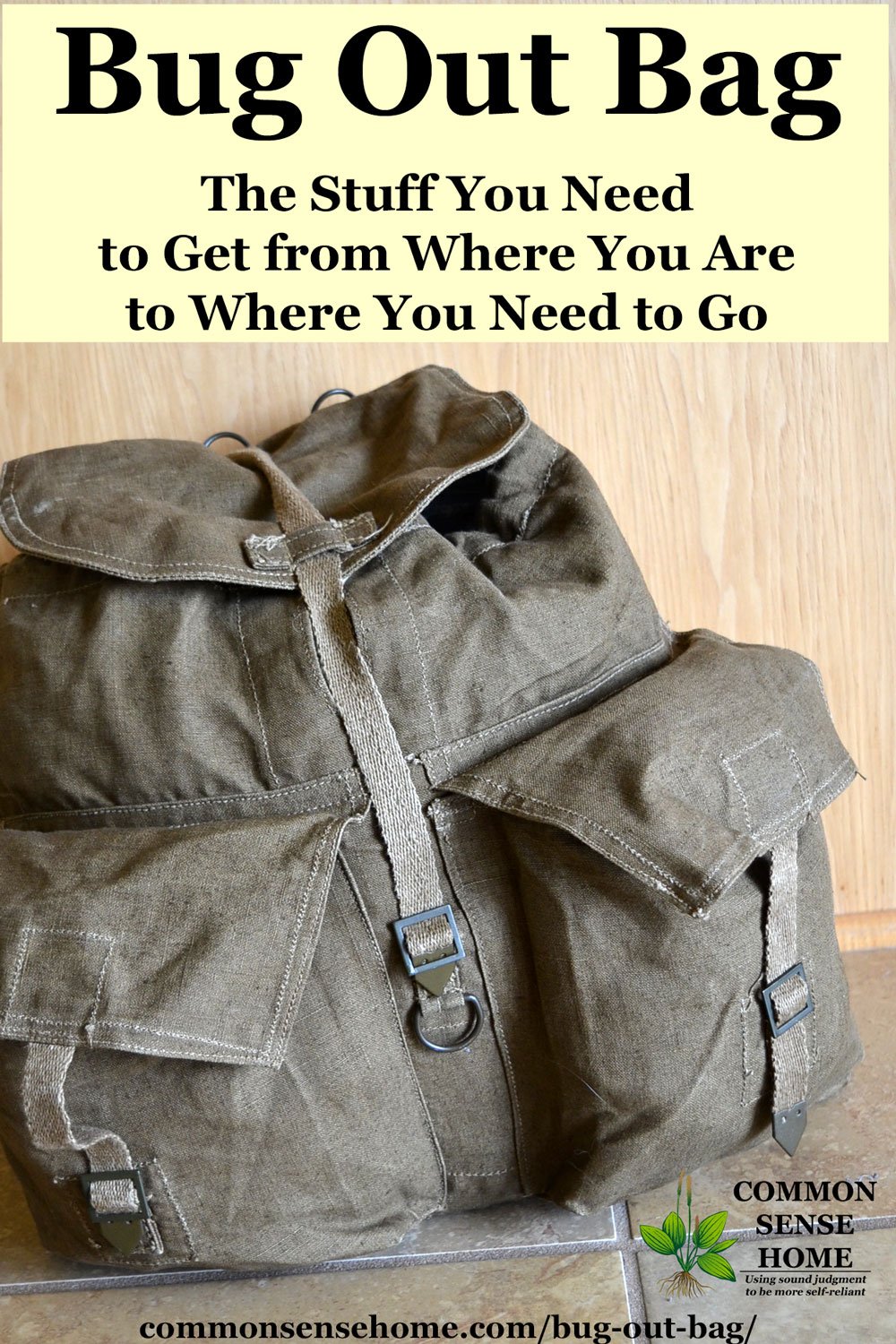
What did we miss?
Feel free to mention things we should add to this post in the notes below. We know this list overlaps completely with the Car Kit post, so review that post also. See the Common Sense Car Kit Post for information on the car kit.
What to put in my car?
We call everything you leave in your car the “trunk stash” (it could be in your glove compartment too). Our stash includes: a first aid kit, a change of clothes, a food and water pack and a supplies bag.
Having a good backpack that can handle the stuff you would grab from the trunk allows you to create your Bug Out Bag or Get Home Bag from the trunk stash. The trunk stash includes all the stuff you would use day to day, and in vehicle emergencies.
You would likely not carry your scissor jack in your bug out bag, but you would likely grab the knife and first aid kit to throw in your Get Home Bag.
You may want to pack your bug out bag purposely for a situation where you wouldn’t have time to grab items from other bags or kits. See also Roadside Emergency Kit Recommendations and Checklist.
Do I really need a bug out bag or car kit?
Hopefully not. But be prepared, because life happens. Unpredictable events occur. Car accidents, snow storms, earthquakes, hurricanes and flat tires when you don’t expect them.
It could be as simple as getting your clothes covered in mud and being thankful for that full change of clothes in the trunk. Or being stuck in a hotel with restaurants and grocery stores closed
A Bug Out Bag, Get Home Kit and a Car Kit are all ways of being prepared for those unlikely but possible bad events. An extra change of clothes in the trunk can be helpful even for small problems, like getting your clothes dirty, or having to travel unexpectedly.
As noted LOCATION is a big part of what you pack. If you are out in the middle of nowhere you will want more options than you will need if you drive from the east side of town to the west, but remember even driving from the east to the west – is a long walk if your car is dead.
Once we were visiting a homeschooling family about an hour away, and our youngest “accidentally” fell into a very large puddle. We ended up wrapping him in a blanket to get him home, but since then we’ve kept an extra set of clothes available for everyone.
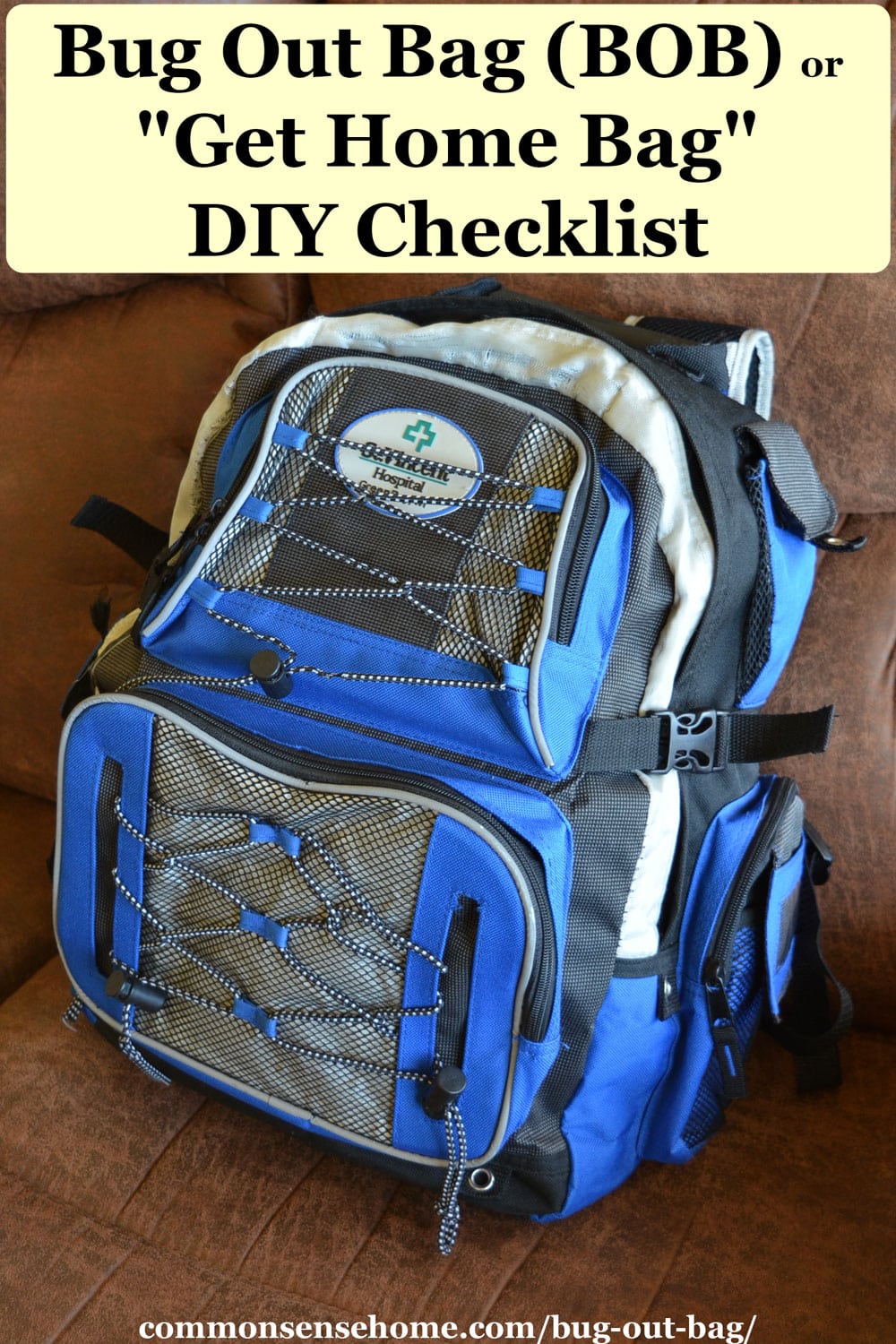
Everyday Emergencies Happen
The food could be lunch when you are stuck in traffic, or traveling long distance when restaurants can’t be found or are closed. A small amount of disaster planning – can help with the day to day unexpected problems.
Having a few supplies in your trunk and a plan to get home, will hopefully never be needed but in an minor or major emergency you will be glad the tools, food and supplies are there.
The zombie apocalypse is not going to happen but an electromagnetic pulse is possible. Even more likely is a snow storm, earthquake, hurricane, power outage or car accident. Know what risks you are likely to face, know the Odds of Everyday Emergencies and be prepared.
We want to be reasonably prepared and want to be able to help our family, our friends and neighbors or at least not be a drain on 911 or FEMA. That is why we have Car Kits, First Aid Kits, reasonable stockpiles of food (freeze dried or dehydrated food), water (couple water bottles and/or a water filter) and general emergency supplies. It’s just Common Sense.
Do you need a semi-trailer to carry your bug out bag?
Okay, we are kidding, but if you Google “Bug Out Bag list”, you will see huge lists.
Those lists include tons of items: 72 hours of food, water, clothing, first aid, fire starter and waterproof matches, radio, flashlight, gear for cooking fishing, magnifying glass, toilet paper, hunting, personal hygiene items, an ax, personal defense items, rope, a tent, sleeping bag, tools, money, weapons, a machete and about 100 additional items.
Do you really need a full long term survival kit? Many websites talk about fitting everything you need for an emergency situation into a single backpack.
There are thousands of versions of BOBs. You can also find a massive amount of websites about “bugging out”. We encourage you to pack smarter, not “more”, and collect skills instead of just “stuff”.
Be the person with their sh*t together, who is well trained, who keeps a level head when things get messy. Knowing where to find water, food, or herbs can make a huge difference. Knowledge doesn’t weigh an ounce.
TIP 1: Consider a full Car Kit and leave a backpack in your trunk. The contents of a BOB overlap with a Car Kit so you could build a BOB from the Car Kit or leave a full BOB in the car as part of your Car Kit.
TIP 2: If you have the room and cash, consider a folding bike. A bike will let you travel at 12 to 16 miles per hour vs. walking at 3 to 5 miles per hour. Getting there 3 to 5 times faster and having a rack for extra stuff makes a HUGE difference.
See the Roadside Emergency Kit Recommendations and Checklist post for more info.
Related Articles

This post was written by August Neverman IV. August has a strong background in emergency preparedness. He served on several emergency preparedness teams during his tenure at Brown County WI Government, the Medical College of Wisconsin, HSHS, a 13-hospital system and emergency response training during his time with the Air Force and Air National Guard. Learn more about August.

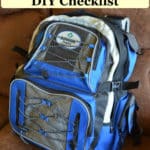
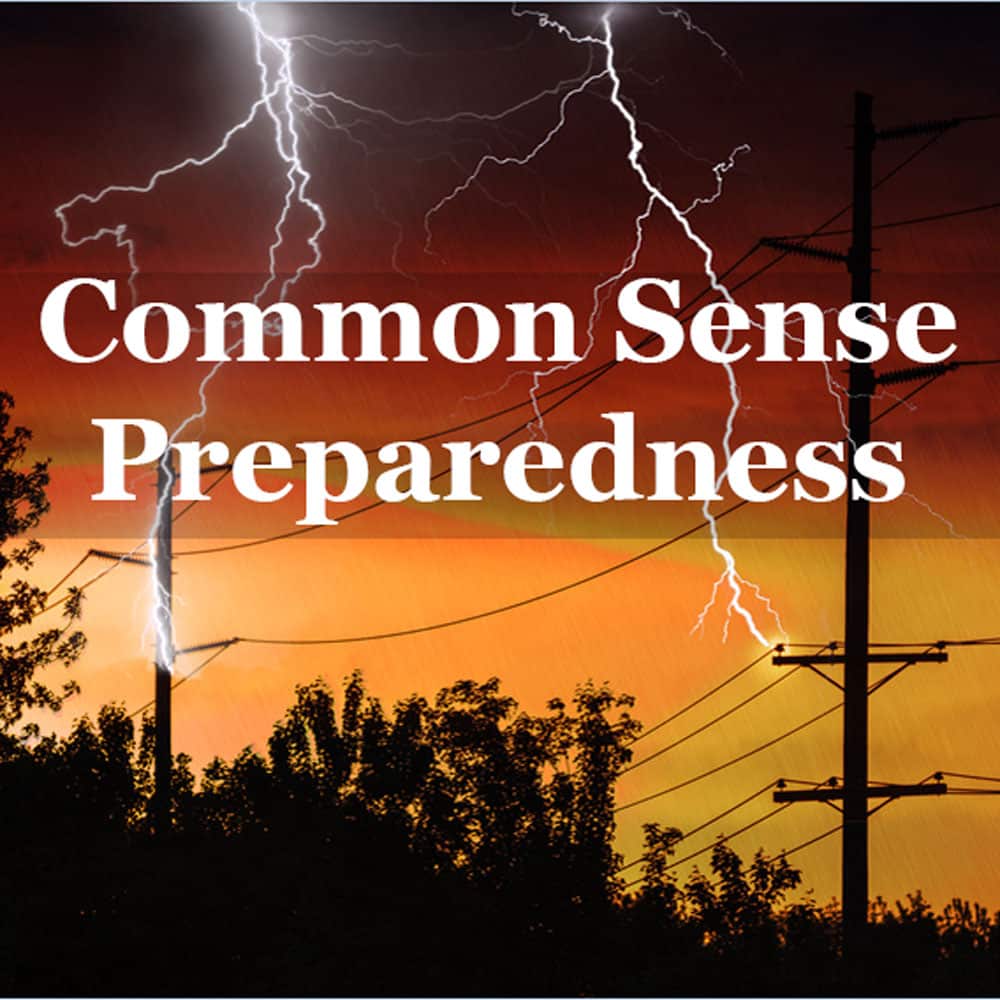
An emergency crank radio w/AM,FM, NOAA WX band is critical. It should have multiple power options (internal replaceable battery pack and AA/AAA battery power option). Earbuds are important so as not to disturb others around you. Have fresh batteries in it, as well as at least one other set of batteries. If time allows, make sure to have the internal battery pack fully charged.
If you don’t already own one, go online and start your research. There are many models out there well equipped and proven for well under $100.00. A good start would be $45.00 to around $65.00.
That is indeed a reasonable suggestion. There are also phone apps that will allow you to listen to emergency broadcasts if space is tight, but the emergency radios typically have more options for charging while mobile.
Because of medical issues, don’t forget to go through or grab your normal everyday gear. My kiddo’s Epi-pen and inhaler are in my purse. I may not have time to dig the pen from the bottom of my purse, but I can grab both bags, sling them on, and get to a safer environment to be a little more picky then with what I am carrying.
If you don’t want to look like you are prepared for the gates of Hell to open up (because people are nosy and will look in the windows of vehicle), put the basics through-out your vehicle. First aid kit, medications [make sure to keep original containers in case of police search] (center console), spare glasses, maps, compass/whistle, eyeglass repair kit, fem products (dash compartment); tarp, cord, tape, emergency blanket, tools, bug spray, sunscreen, the actual bag (spare tire well or jack compartment); spare clothing/foods and the like (a trash bag in cargo area, people are less likely to steal “trash”).
Carry 2 gal of water in vehicle (if anything for a radiator, or what not) that you can then disperse either into water bottles that may have collected in the cab of vehicle or drink before heading out from the vehicle. The key with water resources: 3 gal a day, includes water eaten and drunk per person. If you are sweating you are already getting dehydrated, if you aren’t sweating and should be, you are in danger of heat stroke. Find/make shade immediately, heat rises so get low and spread out limbs to disperse heat faster. Always sip water, don’t guzzle. Allow your body to acknowledge, acclimate, and absorb the water, or you will end up vomiting it, wasting both the water and energy you don’t have.
I like having my speedy stitcher in my bug out bag for simple gear repairs or modifications. http://www.speedystitcher.com/
Thank you for sharing!